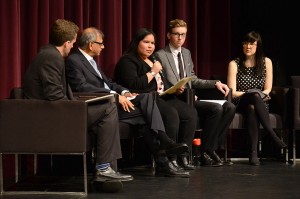
Smart and Caring Communities panel discussion at the Kay Meek Centre in West Vancouver. Photo source: The Office of the Secretary to the Governor General. The original photo can be found at gg.ca.
March 10, 2016 – UBC arts student and Squamish Nation member Adina Williams was a member of a distinguished panel in West Vancouver last week, which included a presentation from the Governor General of Canada, The Honourable David Johnston.
The Sea to Sky Community Foundations hosted the event as part of its response to the Governor General’s call to action five years ago to “build a smarter, more caring nation and a fairer, more just world.”
Below is a copy of Ms. Williams’ prepared remarks.

UBC student Adina Williams (middle) of the Squamish Nation at a Smart and Caring Communities panel discussion in West Vancouver. Photo credit: Sonya Adloff, West Vancouver Schools
What does a smart and caring community mean to me?
Well, in the broadest sense, a smart and caring community is simply one in which people are consistently working together, whether that be people coming together during a time of need, or people coming together in celebration during a time of success.
And while I certainly do see this in my community, which I see as the Squamish Nation community, I think we have a little ways to go in creating a community that’s larger and more holistic.
What I mean (by that) is that up until I was in my mid-teens, when I thought of my community, I thought of my reserve, and that’s it. Of course there were many smaller units within my reserve that I saw as my community, such as my individual family, but it was the reserve that was the largest community to which I felt I belonged, and anywhere beyond that, anything external to the reserve, was another community…another community to which I didn’t belong.
Now, because of various means that I will elaborate on further during our discussion, I realize and truly do believe that I am a part of this greater community on the North Shore, in addition to my First Nations community.
But I do know that there are still many people in the First Nations community who still feel today like how I felt when I was 15/16 years old. That they do not belong outside the reserve, and that the reserve is the only place where they can find a community such as the one that I described at the beginning.
But I do believe that it’s possible to have a larger community, starting right here on the North Shore and then working beyond that, where everybody, Aboriginal and non-Aboriginal, are working together. We’re certainly progressing towards it now, but my vision of a smart and caring community is one in which every Aboriginal individual feels a part of this larger community. That’s what a smart and caring community means to me, and I truly believe that it’s possible to achieve in the near future.
What do you see in our area that brings hope and excitement when you think about the community we have talked about today?
I certainly see increased ambition amongst my peers from my First Nations community, such that many of the Aboriginal youth my age, take myself for example, are finding community external to those within the reserve, for example, going to post-secondary and going into the workforce, and excelling in these places. I believe that this is a result of support and encouragement from both inside and outside the First Nations community. I found that support particularly at school, from leaders like Brad Baker, who said to me, “yes, your contributions as an Aboriginal person are valuable, and yes, you do belong here. This is your community too.”
Are there things changing in our community?
Most definitely. When I began public speaking in grade 10/11, and I began doing so in my language and according to my traditional/cultural protocols, I often had non-Indigenous people asking me why I was doing such work, and they further went on to tell me that nobody cared about it, that it wasn’t important, and that I should consider giving it up. It was very challenging for me to understand why nobody cared about my culture. Indeed, those remarks were so influential, that I even found myself questioning the importance of the work I was doing. Sometimes I still feel that discomfort, or perhaps even annoyance, from others when I’m sharing a part of who I am as an Indigenous/Sḵwx̱ú7mesh person, but more often than not, I’m finding a mutual pride in it, often a lot of curiosity, and most importantly, a genuine welcome in this greater community.
If you had one wish for those here in attendance today that they would move forward, what would it be?
For me, it all begins with a simple welcome to the Indigenous community, perhaps a simple thank you to those Indigenous persons who contribute to this community, or a simple acknowledgement of the traditional territories, out here in the greater community. I certainly feel like I belong here now, but the rest of my people need to know that they belong here too. When we all feel this sense of belonging in the greater community, with each other, I see that as a step towards reconciliation, and once this happens, we’ll have the smart and caring community that I can imagine is possible.
@chrkennedy @GGDavidJohnston Huy Chexwa for giving me the opportunity to speak. My hands are raised in the highest respect.
— Adina Williams (@AdinaRWilliams) March 4, 2016
Comments are closed, but trackbacks and pingbacks are open.